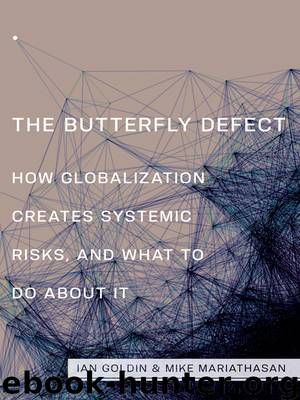The Butterfly Defect by Goldin Ian Mariathasan Mike

Author:Goldin, Ian, Mariathasan, Mike
Language: eng
Format: epub
Publisher: Princeton University Press
Published: 2014-06-25T16:00:00+00:00
LESSONS FROM PANDEMIC MANAGEMENT
David M. Bell et al. contrast the measures taken to deal with the H1N1 virus (swine flu) in Mexico City and New York in 2009. In Mexico the government invoked its emergency powers on 24 April in anticipation of widespread panic. These allowed the authorities to engage in an intensive media campaign, as well as to put measures in place for social distancing and the dissemination of antiviral drugs. In an attempt to control the spread of the virus through the education system, the government instigated the screening of all schoolchildren throughout the country. The fragmented nature of Mexican health care, however, meant that the government had difficulty coordinating its actions among the three major health care systems. As a result, laboratory capacity in Mexico was too limited to deal with the crisis, and estimates of the overall bill are over US$2.3 billion, the equivalent of 0.3 percent of Mexico’s GDP.81
In New York, on the other hand, the public campaign was associated with only the occasional closure of schools and instead put emphasis on existing health mechanisms. The emergency stocks of vaccine compiled by local authorities were in the end not needed because “normal distribution channels” continued to function sufficiently.82 The problems in New York instead related to individuals who lived, worked, and commuted through different administrative jurisdictions. This should emphasize that although the ability to respond to threats in a flexible manner is required, the importance of preplanning and preparation cannot be overstated.
Picking up on this same message, Marguerite Pappaioanou, professor of infectious disease epidemiology at the University of Minnesota, advocated “basic strategies” to minimize pandemic risk. These primarily involved limiting human exposure to animals, particularly among high-risk groups such as farmers, vendors, and those involved in the transport of live animals.83 Coupled with this, Pappaioanou wrote that she considered vaccination the most effective preventive approach to pandemic risk and hence advocated “continued virologic and disease surveillance of Avian influenza virus in humans, poultry, and swine.” This, she argued, is “essential” to monitor pandemic risk and to properly prepare for outbreaks.84 In her conclusion Professor Pappaioanou cited WHO’s “five priority actions for optimal pandemic prevention and preparedness,” with respect to bird flu specifically:
• Reduce human exposure to the virus.
• Strengthen early warning systems.
• Intensify rapid containment operations.
• Build coping capacity.
• Coordinate global research.85
Although these specific actions relate to H1N1, we can see that their usefulness is far more general. Larry Brilliant has summarized the two simple principles involved: “The key to eradicating smallpox was early detection, early response.”86 In sum, there are three crucial lessons to be learned for systemic thinking regarding the health risks arising from globalization.
Lesson 1: To identify risks, mechanisms for early detection are essential
The difficulty associated with managing pandemics grows exponentially with the number of people affected. The key is to locate the pathogen at its source, then isolate and contain it. As Dr. Brilliant has stressed, “You can’t cure or prevent what you don’t know is there.”87 The Web provides global
Download
This site does not store any files on its server. We only index and link to content provided by other sites. Please contact the content providers to delete copyright contents if any and email us, we'll remove relevant links or contents immediately.
International Integration of the Brazilian Economy by Elias C. Grivoyannis(98982)
The Radium Girls by Kate Moore(11973)
Turbulence by E. J. Noyes(7978)
Nudge - Improving Decisions about Health, Wealth, and Happiness by Thaler Sunstein(7657)
The Black Swan by Nassim Nicholas Taleb(7056)
Rich Dad Poor Dad by Robert T. Kiyosaki(6513)
Pioneering Portfolio Management by David F. Swensen(6256)
Man-made Catastrophes and Risk Information Concealment by Dmitry Chernov & Didier Sornette(5956)
Zero to One by Peter Thiel(5732)
Secrecy World by Jake Bernstein(4700)
Millionaire: The Philanderer, Gambler, and Duelist Who Invented Modern Finance by Janet Gleeson(4421)
The Age of Surveillance Capitalism by Shoshana Zuboff(4245)
Skin in the Game by Nassim Nicholas Taleb(4203)
Bullshit Jobs by David Graeber(4140)
The Money Culture by Michael Lewis(4134)
Skin in the Game: Hidden Asymmetries in Daily Life by Nassim Nicholas Taleb(3961)
The Dhandho Investor by Mohnish Pabrai(3722)
The Wisdom of Finance by Mihir Desai(3694)
Blockchain Basics by Daniel Drescher(3540)
